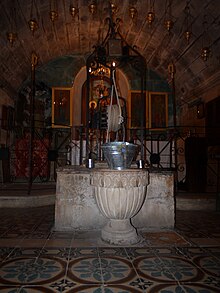Religious significance
Jacob's Well is named in the New Testament Gospel of John as the scene of Jesus's encounter with the Samaritan woman:
So [Jesus] came to a town in Samaria called Sychar, near the plot of ground Jacob had given to his son Joseph. Jacob's well was there, and Jesus, tired as he was from the journey, sat down by the well. [3]
The location of Sychar is uncertain; it may have been a town on the eastern slopes of Mount Ebal, or it may be another name for Shechem. [4] Jacob is an Old Testament patriarch whose story is told in the Hebrew Book of Genesis. There is no specific mention in the Hebrew Bible of a well owned by Jacob, but the plot of ground described as the location of the well is considered by biblical scholars to be identical with the plot purchased by Jacob in Genesis 33, which was said to be "within sight" of Shechem. [2] [5]
The present-day church at Balata village is close to the archaeological site of Tell Balata, traditionally identified with Shechem. [6] The well within this church has long been associated with the New Testament narrative, and Christian tradition therefore holds this well to have been dug by Jacob. [2] The same belief is found among the Samaritans. [2] [7] Scholars such as James Hastings and Geoffrey W. Bromiley assert that Jewish tradition likewise connects the well with Jacob, [2] [1] but David Gurevich and Yisca Harani claim that "Judaism does not attribute any religious significance to the site". [7]
History
The writings of pilgrims indicate that Jacob's Well has been situated within different churches built at the same site over time. [1] [2] By the 330s AD, the site had been identified as the place where Jesus held his conversation with the Samaritan woman, and was probably being used for Christian baptisms. [8] By 384 AD, a cruciform church was built over the site, and is mentioned in the 4th century writings of Saint Jerome. [8] This church was most likely destroyed during the Samaritan revolts of 484 or 529 AD. [8] Subsequently, rebuilt by Justinian I, this second Byzantine era church was still standing in the 720s AD, and possibly into the early 9th century AD. [8]
The Byzantine church was definitely in ruins by the time the Crusaders occupied Nablus in August 1099 AD; early 12th-century accounts by pilgrims to the site speak of the well without mentioning a church. [8] These include the appointment of Henry Maleverer as guardian of the well under the king of Jerusalem. [9] There are later 12th-century accounts of a newly built church at Jacob's Well. The first such definitive account comes from Theoderic, who writes: "The well ... is a half a mile distant from the city Nablus: it lies in front of the altar in the church built over it, in which nuns devote themselves to the service of God. This well is called the Fountain of Jacob." [8] This Crusader era church was constructed in 1175, likely due to the support of Queen Melisande, who retired to Nablus in 1152 where she lived until her death in 1161. [10] This church appears to have been destroyed following Saladin's victory over the Crusaders in the Battle of Hittin in 1187. [1] [2]
In March 1697, when Henry Maundrell visited Jacob's Well, the water stood at 5 feet (1.5 m) deep of the well's total depth of 35 feet (11 m). [2] [11] Edward Robinson visited the site in the mid-19th century, describing the "remains of the ancient church," lying just above the well to the southwest as a "shapeless mass of ruins, among which are seen fragments of gray, granite columns, still retaining their ancient polish." [12] Local Christians continued to venerate the site even when it was without a church. In 1860, the site was obtained by the Greek Orthodox Patriarchate and a new church, consecrated to St. Photini the Samaritan, was built in 1893 along with a small monastery. [13] The 1927 Jericho earthquake destroyed that building.
In November 1979, at a time of increased tensions on the West Bank, the custodian of the well, Archimandrite Philoumenos, was found hatcheted to death inside the crypt housing the well. The assailant, a mentally ill resident of Tel Aviv, was apprehended three years later and confessed to that slaying and others, including an assault on a nun at the monastery and the axe murder of a Jewish psychiatrist in Tel Aviv. [13] [14] [15] [16] In 2009, the Greek Orthodox Patriarchate of Jerusalem declared Philoumenos a saint thirty years after his death.
Abuna (meaning "Father") Ioustinos, a Greek Orthodox priest from Nablus, later spearheaded a huge reconstruction project. Jacob's Well has since been restored and a new church modelled along the designs of the Crusader-era church houses the well inside it, in a crypt on a lower level. [10]
Physical description and location
Jacob's Well is located 76 meters (249 ft) from Tell Balata in the eastern part of the city of Nablus within the grounds of the Bir Ya'qub monastery. [1] [10] The well is accessed by entering the church on the monastery grounds, and descending the stairs to a crypt where the well still stands, along with "a small winch, a bucket, ex-voto icons and lots of lit candles." [17]
According to Major Anderson, who visited the site in 1866, the well has:
"...a narrow opening, just wide enough to allow the body of a man to pass through with arms uplifted, and this narrow neck, which is about 4 ft. long, opens into the well itself, which is cylindrically shaped, and opens about 7 ft. 6 in. in diameter. The well and upper part of the well are built of masonry, and the well appears to have been sunk through a mixture of alluvial soil and limestone fragments, till a compact bed of mountain limestone was reached, having horizontal strata which could be easily worked; and the interior of the well presents the appearance of having been lined throughout with rough masonry." [1]
Based on a measurement made in 1935, the total depth of the well is 41 meters (135 ft). [1]
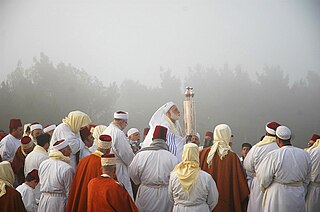
The Samaritans, also known as Israelite Samaritans, are an ethnoreligious group originating from the Hebrews and Israelites of the ancient Near East. They are indigenous to Samaria, a historical region of ancient Israel and Judah that comprises the northern half of today's West Bank. They are adherents of Samaritanism, an Abrahamic, monotheistic, and ethnic religion that developed alongside Judaism.

Samaria is the Hellenized form of the Hebrew name Shomron, used as a historical and biblical name for the central region of Israel, bordered by Judea to the south and Galilee to the north. The region is known to the Palestinians in Arabic under two names, Samirah, and Mount Nablus.
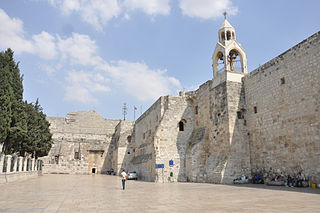
The Church of the Nativity, or Basilica of the Nativity, is a basilica located in Bethlehem, West Bank, Palestine. The grotto holds a prominent religious significance to Christians of various denominations as the birthplace of Jesus. The grotto is the oldest site continuously used as a place of worship in Christianity, and the basilica is the oldest major church in the Holy Land.
Adummim is a place-name mentioned in the biblical Book of Joshua in connection with the ascent of Adummim.
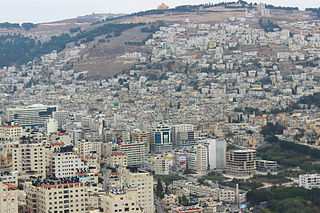
Nablus is a Palestinian city in the West Bank, located approximately 49 kilometres (30 mi) north of Jerusalem, with a population of 156,906. Located between Mount Ebal and Mount Gerizim, it is the capital of the Nablus Governorate and a commercial and cultural centre of the State of Palestine, home to An-Najah National University, one of the largest Palestinian institutions of higher learning, and the Palestine Stock Exchange. Nablus is under the administration of the Palestinian National Authority (PNA).

Shechem, also spelled Sichem was an ancient city in the southern Levant. Mentioned as a Canaanite city in the Amarna Letters, it later appears in the Hebrew Bible as the first capital of the Kingdom of Israel following the split of the United Monarchy. According to Joshua 21:20–21, it was located in the tribal territorial allotment of the tribe of Ephraim. Shechem declined after the fall of the northern Kingdom of Israel. The city later regained its importance as a prominent Samaritan center during the Hellenistic period.

Mount Gerizim is one of two mountains in the immediate vicinity of the Palestinian city of Nablus and the biblical city of Shechem. It forms the southern side of the valley in which Nablus is situated, the northern side being formed by Mount Ebal. The mountain is one of the highest peaks in the West Bank and rises to 881 m (2,890 ft) above sea level, 70 m (230 ft) lower than Mount Ebal. The mountain is particularly steep on the northern side, is sparsely covered at the top with shrubbery, and lower down there is a spring with a high yield of fresh water. For the Samaritan people, most of whom live around it, Mount Gerizim is considered the holiest place on Earth.

Emmaus is a town mentioned in the Gospel of Luke of the New Testament. Luke reports that Jesus appeared, after his death and resurrection, before two of his disciples while they were walking on the road to Emmaus.

Church of the Sepulchre of Saint Mary, also Tomb of the Virgin Mary or the Church of the Assumption, is a Christian church built around an ancient Jewish rock-cut tomb in the Kidron Valley – at the foot of Mount of Olives, in Jerusalem – believed by Eastern Christians to be the burial place of Mary, the mother of Jesus. The Status Quo, a 250-year old understanding between religious communities, applies to the site.

John 4 is the fourth chapter of the Gospel of John in the New Testament of the Christian Bible. The major part of this chapter recalls Jesus' interaction with the Samaritan woman at the well in Sychar. In verses 43-54, he returns to Galilee, where he heals a royal official's son.
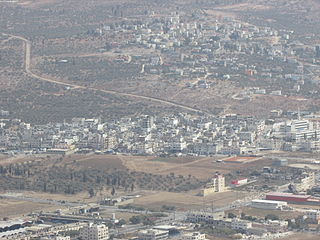
Askar is a Palestinian refugee camp. It is located on the outskirts of the West Bank city of Nablus and was established in 1950 on 119 dunums of land. Residents of the camp refer to this as “New Askar”.

Joseph's Tomb is a funerary monument located in Balata village at the eastern entrance to the valley that separates Mounts Gerizim and Ebal, 300 metres northwest of Jacob's Well, on the outskirts of the West Bank city of Nablus. It has been venerated throughout the ages by Samaritans, for whom it is the second holiest site; by Jews; by Christians; and by Muslims, some of whom view it as the location of a local sheikh, Yusef al-Dwaik or Dawiqat, who died in the 18th century.

Al-Khadra Mosque also known as Hizn Sidna Yaq'ub Mosque, is a mosque situated on the lower slopes of Mount Gerizim in the southwestern quarter of the Old City of Nablus in the West Bank. The mosque is rectangular in shape, and its minaret rises 30 meters (98 ft).

Balata village is a Palestinian suburb of Nablus, in the northern West Bank, located 1 kilometer (0.62 mi) east of the city center. Formerly its own village, it was annexed to the municipality of Nablus during Jordanian rule (1948–67). The village contains a number of well known sites: Tell Balata, Jacob's Well and Joseph's Tomb.

Tell Balata is the site of the remains of an ancient Canaanite and Israelite city, identified since 1913 with the Biblical city of Shechem. It is located in the West Bank. The built-up area of Balata, a Palestinian village and suburb of Nablus, covers about one-third of the tell, and overlooks a vast plain to the east. The Palestinian village of Salim is located 4.5 kilometers (2.8 mi) to the east.

Mar Elias Monastery is a Greek Orthodox monastery in south Jerusalem, on a hill overlooking Bethlehem and Herodium, near Hebron Road.
Philoumenos (Hasapis) of Jacob's Well was the Hegumen of the Greek Orthodox monastery of Jacob's Well, from the city of Nablus (Neapolis) in the West Bank. He was murdered on 29 November 1979 by a mentally ill Jewish man.

The Church of Saint John the Baptist is a Catholic church in Ein Karem, Jerusalem, that belongs to the Franciscan order. It was built at the site where Saint John the Baptist is believed to have been born.
Asher Raby is an Israeli serial killer. Subsequently declared mentally ill, he killed five people in several attacks committed across the country from March to November 1979, with the most prominent of them being Philoumenos Hasapis, the Greek Orthodox hegumen of Jacob's Well. Deemed unfit to stand trial for his crimes, he was acquitted by reason of insanity and confined to a psychiatric facility.
